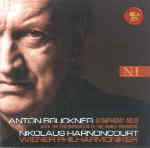This very interesting and worthwhile disc offers an excellent reason to acquire yet another Bruckner Ninth. As usual, Harnoncourt offers a “concept”, and as with his recent Smetana Ma Vlast, this one works extremely well. First, he presents a lecture concert (a synopsis of his remarks is translated into English in the booklet) consisting of all the music for the finale that Bruckner actually put into performable shape. This strikes me as a much better solution than to play one of the conjectural completions, none of which makes a very convincing case for this movement. Apparently pages were removed from the composer’s manuscript after his death by the nefarious Schalk brothers (or some equally dastardly culprit) and given away as souvenirs. Even today some are coming to light, so if you have any loose papers in your attic or basement and any of your relatives was hanging around Vienna around the turn of the last century, take a close look before you toss them out.
Then comes the main item: the symphony itself in the form of yet another “new critical edition” that sounds identical in all significant ways to what we have heard before. It’s Harnoncourt who makes all the difference. This is the most savage performance since Jochum’s Dresden recording, and we all know how wonderful that one is. There are moments in the first movement and scherzo where it sounds as though Bruckner was writing a sort of proto-Austrian Rite of Spring. Tempos are generally swift, the playing outstanding. In the first movement Harnoncourt is particularly adept at “getting” from one place to the next. All of those typically Brucknerian passages consisting of sequences repeated millions of times leading, say, from the mysterious opening gestures to the big unison tune, or from there to the songful second subject, never outstay their welcome. The impression of inexorable forward momentum never flags, not even during the long lead back to the recapitulation, and the first movement coda sounds terrifying, as if etched in stone.
The most interesting thing about the scherzo, apart from the wonderfully mean and nasty outer sections, is the way that Harnoncourt refuses to slow down in the sighing, lyrical parts of the otherwise swift central trio. It works wonderfully, and I note in passing that even though everyone in history makes a big ritard at this point, and even though I own only the “original edition” and the “new critical edition” and not the “really truly super-duper new critical edition” that Harnoncourt uses, in none of my sources does Bruckner himself suggest any slowing down at all. Now you can hear for yourself that once again the composer was right and the rest of the musical universe was wrong. For me, this alone is worth the price of the disc. But then, hard-core collectors live for such things, and normal people can rest assured that they will be equally enthralled.
Harnoncourt’s finale is in some ways the most interesting movement of all. At a mere 24 minutes it might be stretching the point to call it zippy, but it’s very swift and aptly angular. What’s so fascinating is the fact that he seems to be trying to rob the music of its “finality” (or maybe, “finale-ness”). It’s interesting to see tempos in this symphony getting slower over time, and in particular to observe the attempts of conductors knowing full well that nothing is coming afterward to give this movement the same musical stature as the first. This is a perfectly legitimate interpretive option, and while Harnoncourt’s performance leaves no emotional stone unturned, you might still come away from this performance willing to accept the possibility that this movement may not have been Bruckner’s last word. One way that Harnoncourt suggests this is not only via the tempo but also (for example) by not stretching out that grinding climactic chord to the expressionistic maximum. The whole passage in question is very exciting and the dissonances are especially crunching because they are so well balanced and clear, but it’s not the “knockout punch” that others have made of it. The ability to communicate large-scale ideas of this sort about musical form and structure is one of several reasons why Harnoncourt remains one of today’s very few musical giants.
Another reason is the superb quality of the playing that he elicits from the Vienna Philharmonic, which of course always plays this music (unlike that of Mahler) with proprietary zeal and consummate style. RCA’s sonics in stereo are remarkably clean, solid, and well balanced, indeed state-of-the-art for a live production coming from the Grosses Festspielhaus in Salzburg. The SACD, though, lacks many of the virtues of the standard version and includes a much less coherent sound stage, inferior impact, and various other oddities of balance and perspective. It’s a pity, I suppose, but I can’t feel sorry about the fact that the way most people still listen to music is the way this outstanding, indeed essential performance ultimately sounds best. [10/11/2003]
































